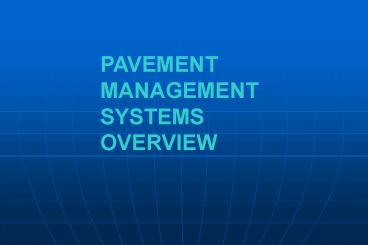PAVEMENT MANAGEMENT SYSTEMS OVERVIEW - PowerPoint PPT Presentation
1 / 27
Title:
PAVEMENT MANAGEMENT SYSTEMS OVERVIEW
Description:
Trucks dominate, 24% increase in traffic. 5.5B tons moved in 1992 $4.5B ... Feedback Process. A variety of processes are used to confirm reliability of PMS ... – PowerPoint PPT presentation
Number of Views:347
Avg rating:3.0/5.0
Title: PAVEMENT MANAGEMENT SYSTEMS OVERVIEW
1
PAVEMENT MANAGEMENT SYSTEMS OVERVIEW
2
Importance of Transportation System
- Transportation Statistics
- U.S. system largest in the world
- 260M People, 6M businesses, 6M km of roads
- Economic Importance
- 11 of GDP, 9.9M employed, 7 of labor force
- Movement of Freight
- Approx 50 of all freight
- Trucks dominate, 24 increase in traffic
- 5.5B tons moved in 1992
- 4.5B moved in 1993
3
Effect of Treatment Timing on Costs
4
Early PMS
- Mid 1960s
- A few agencies began to develop pavement
condition surveys and used data to help develop
project lists. - Mid 1970s
- Systems approach began to be envisioned and
actively developed - Washington, Arizona, Utah, South Dakota, USA-COE
5
1986 AASHTO Guidelines
- Introduced and defined PMS
- Supported development and implementation of PMS
6
1989 FHWA PMS Policy
- Required all states to have PMS to manage their
Federal Aid Highways (Interstate, Principal) - Condition of funding
7
Scope of 1990 AASHTO Guidelines
- Described the basic characteristics
- Identified the components of a PMS and role
- Described development, implementation and
operation steps - Described the products
- Defined the role of communications
8
1990 AASHTO Guidelines for PMS
- A Pavement Management System is designed to
provide objective information and useful data for
analysis so that highway managers can make
consistent, cost-effective, and defensible
decisions related to the preservation of a
pavement network.
9
Intermodal Surface Transportation Efficiency Act
of 1991
- Required all States to have a PMS that covered
all Federal - Aid Highways - Tripled network covered
- - 916,200 centerline miles
- Rescinded in 1995
- Regulations
- Non-prescriptive, federal-aid funds eligible
development, implementation and annual operation
of PMS
10
Current State of Practice in PMS
- Different PM methodologies Used
- 50 use
- pavement condition analysis
- 50 use
- network optimization
- priority assessment
- other approach
11
Network Level PMS
- Establish network budget requirements
- Allocate funds to network priorities
- Schedule MRR actions
12
Network Level Products
- Pavement network condition
- MRR policies
- Budget requirements
- Network priorities
13
Project Level PMS
- Primary objective is to provide information for
specific pavement segments - Preferred MRR for each project
- MRR costs
- Expected MRR performance.
14
Typical Modules of a PMS
- Database
- At a minimum, data necessary for PMS analysis
- Analysis
- Methods to generate products useful for
decision-making - Feedback
- Use of on-going field observations to improve the
reliability of the PMS
15
PMS Component - Data Collection
- Inventory
- Physical features incl. no. of lanes, length,
width, surface type, functional class., shoulder
type - History
- Dates of construction, rehabilitation
- Condition Survey
- Pavement distress, IRI, rutting, surface friction
- Traffic
- Volume, vehicle type, load data
- Data Base
16
Inventory Data
- Route Number
- Functional Class
- Length
- Pavement Type
- Pavement Width
- Lane Number and Width
- Shoulder Type and Width
- Layer Thickness
- MRR History
17
Traffic/Load Data
- ADT (used to establish priorities)
- ESAL (for prediction and treatment selection)
18
Pavement Condition Survey
- Ride quality or roughness
- Physical distress
- Structural capacity
- Safety
19
Pavement Condition Survey(other issues)
- Historical
- Rate of deterioration over time under accumulated
traffic loads - Frequency
- Depends on the type and age of pavement measured
as well as the cost of the survey and the need
for timely data - Quality Control
- Inventory and condition data is essential to the
success of a PMS
20
Analysis
- Condition Analysis
- IRI, PCI, PDI, etc.
- Performance Analysis
- Condition projection, remaining service life
- Investment Analysis
- Network Project level, life-cycle costs
- Engineering Analysis
- Evaluation of design, construction, rehab,
materials, etc. - Feedback Analysis
- Evaluation and updating of procedures and
calibration of relationships
21
Condition Analysis
- Combines the pavement distress data into a score
or index - Represents overall pavement condition
- Describes system condition
- Uses priority ranking scheme
- Uses decision tree approach as primary criteria
to select project, timing, and treatments
22
Condition Analysis Outputs
- Ranking of pavement segments by condition index
- Identification of MRR strategies and timing for
individual pavement segments - Estimate of funding needs for selected treatments
23
Database Reports
- Pavement Condition Deficiency Reports
- Pavement Condition Performance Histories
- MRR Actions
- Pavement Inventory and Ranking
24
Prioritization Models
- Optimal MRR strategies based on life cycle costs
- Projects are prioritized at the network level
- Benefit/cost ratio and cost effectiveness are
more prevalent methods
25
Prioritization Output
- Prioritized listing of projects requiring action
- Costs for MRR treatments
- Funding needs to meet desired network condition
- Single-year and multi-year with segments
treatment timing and cost identified
26
Budget Requirements
- Provide an estimate of budget requirements
- At prescribed levels of performance
27
Feedback Process
- A variety of processes are used to confirm
reliability of PMS

